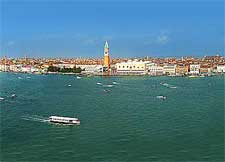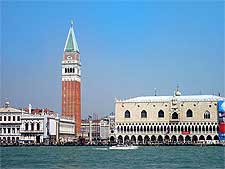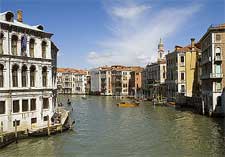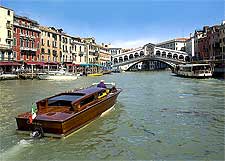Venice History Facts and Timeline
(Venice, Veneto, Italy)

To uncover Venice's history, we need to step back in time to the 5th century AD, when Attila the Hun invaded Italy. Some of those who fled from his army ended up on a chain of tiny islands along the Adriatic Coast.
A few chose to stay, and settlements slowly grew up here. Eventually, a form of administration was put in place. The date of the first Venetian Doge's election remains something of a mystery. There are those who believe that it was as early as 697 AD.
In the early 9th century, Venice came under attack from a Frankish army. Pirates were also particularly troublesome at this time. Such attacks not withstanding, in the years leading up to the Middle Ages, the city grew to become a lively commercial centre, something that was no doubt helped by its strategic location. Much of Venice's architectural history was written at this time. In particular, work began on the Doge's Palace in around 814 AD.

Medieval Period
At the end of the 10th century, the city was awarded the right to trade with the Byzantine Empire. Such an alliance helped to increase the city's wealth considerably. By 1082, Venice was able to free itself from its former masters and become an independent city again. In the 13th century, the city became even wealthier by supplying ships and provisions to Crusader armies. Venetian influence spread even further afield thanks to the adventures of Marco Polo, who left Venice to head to China in 1271.
During the Middle Ages, Venice sought to expand its territories, something that often brought it into conflict with other cities, such as
Genoa. One particular struggle ended in the Battle of Chioggia in 1380. In 1489, it conquered Cyprus. However, Venice also found that it had to protect its own territories as they came under attack.

From the 15th century, Venice started to lose some of its former status. This may partly have been the result of losing a number of its eastern territories to the Ottoman Turks. It may also have been caused by the growing popularity of other trading routes. Whatever the reason, the city's fall from favour continued into the 16th century and even beyond.
Then, in 1797, Napoleon defeated the Venetian Republic and introduced his own government. Later, it fell into Austrian hands. It wasn't until 1866 that Venice was able to become part of a new Kingdom of Italy.
History from the 19th Century
In the 19th century, Venice became an enthusiastic patron of the arts. Exhibitions were held here, including the first International Art Exhibition, which was attended by Umberto I. From the mid-1850s, the city was linked to the mainland for the first time by a railway, making it much easier for visiting tourists to admire the sights. In 1932, the very first Venice Film Festival was held here.

The Second World War Onwards
During World War Two, Venice escaped with very little bomb damage, being liberated by Allied forces in April 1945. In 1966, the city was not so fortunate. A terrible flood destroyed many of its most historic buildings and precious treasures.
Then, in 1996, the Teatro La Fenice opera house, opened in the 1790s, was razed to the ground as a result of fire. This historic building has since re-opened to the public. Recently, flood prevention work has also started to be put into place, which it is hoped will prevent any further such catastrophes in the city.
 To uncover Venice's history, we need to step back in time to the 5th century AD, when Attila the Hun invaded Italy. Some of those who fled from his army ended up on a chain of tiny islands along the Adriatic Coast.
To uncover Venice's history, we need to step back in time to the 5th century AD, when Attila the Hun invaded Italy. Some of those who fled from his army ended up on a chain of tiny islands along the Adriatic Coast.
 From the 15th century, Venice started to lose some of its former status. This may partly have been the result of losing a number of its eastern territories to the Ottoman Turks. It may also have been caused by the growing popularity of other trading routes. Whatever the reason, the city's fall from favour continued into the 16th century and even beyond.
From the 15th century, Venice started to lose some of its former status. This may partly have been the result of losing a number of its eastern territories to the Ottoman Turks. It may also have been caused by the growing popularity of other trading routes. Whatever the reason, the city's fall from favour continued into the 16th century and even beyond.